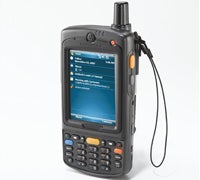 |
Motorola MC75 Source: Motorola |
Motorola (NYSE: MOT) newest enterprise digital assistant (EDA) looks and feels very much like its predecessor, the MC70, but that’s where the similarity ends. The MC75 features third-generation (3G) WAN capability as well as simultaneous voice and data operation.
“From customer feedback we know the form factor is fine but that users want more functionality, said Sheldon Safir, director of Motorola’s mobile computing division, told InternetNews.com. He added that the MC75 is “a bigger leap to provide faster and broader voice and data.”
This new model from Motorola comes as mobile workers are under increasing pressure to send data quickly and accurately, says David Krebs, director, mobile and wireless practice, VDC Research, told InternetNews.com.
“Building on the success of the MC70, Motorola’s MC75 offers enhanced data and voice communications as well as image capture capabilities,” he said.
The enhanced connectivity features, such as the ability to make a call while e-mailing a document and photo file, are aligned with mobile users needs, according to Motorola.
Additional new features in the EDA, the first new device in the MC70 line since Motorola (NYSE: MOT) acquired
Symbol Technologies in late 2006, include a 2-megapixel color camera that lets users attach photos to text files, as well as enhanced battery life and improved security. In addition, the MC75 is as rugged as the MC70 that debuted two years ago.
The device runs on Windows Mobile 6.0 and relies on the HSDPA and CDMA-EVDO standards. It’s also compatible with multiple 3G WAN network standards
“However, as rugged handheld devices such as the MC75 are priced at a premium over nonrugged PDAs and smartphones, significant education especially among first-time users is required to overcome initial adoption cost concerns,” he said.
Safir noted that the new security enhancements include the ability to encrypt data on a card and that Windows Mobile 6.1 offers improved security over version 6.0 used in the MC70 device. It also features 1D and 2D bar code scanning, as well as enhanced GPS that allows for more real time location-based applications and greater battery life.
While the MC70 was primarily targeted for industries such as postal delivery and emergency first responders, the MC75’s broader applications make it appealing to many other segments such as field sales and field service, Safir said.
“It’s finding new niche user populations and a broader universe of potential users,” he said, adding that more than 400,000 MC70 units were sold in just two years, and that Motorola is hoping to keep that momentum moving forward.
The device functionality is right in line with today’s enterprise data needs, according to one industry pundit.
Ken Dulaney, vice president, mobile and wireless at Gartner (NYSE: IT), told InternetNews.com that the MC75 should appeal to the WAN market.
“What we will see from all players are devices that are smaller at lower price points to appeal to more segments of the market,” Dulaney said, noting that additional improvements in supply chain processing using data collection is a big benefit to business.
“The mobile operators will see good solid revenues from these devices as more data is transferred,” he added.


